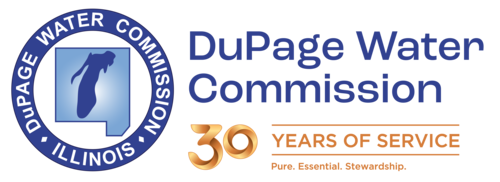The Long Journey Begins
The water’s journey begins two miles off the Chicago shoreline in Lake Michigan at water intake structures called “cribs.” These cribs, located in 35-foot deep water, have served the Chicagoland area since their construction about 100 years ago.
Lake Michigan water enters the cribs through openings 20 feet below the lake’s surface. The water rises around the outside of a large pipe inside the crib then flows through a 20 foot diameter tunnel to the James W. Jardine Water Purification Plant, the largest water treatment plant in the world, located just north of Chicago’s Navy Pier.
Upon reaching the plant, the water is pumped to a height of about 20 feet above lake level. Water flows, by gravity, through the chemical application channels and basins of the plant. In the treatment channel, chemicals like alum are added to collect and remove impurities from the water. Powdered activated carbon is added as necessary to improve taste and remove odors, enhancing the quality of the water. The initial dosage of chlorine is added to kill bacteria.
Next, the water flows into chambers called flocculation basins. Here large paddles stir the water slowly to form flocs, clusters of impurities that look like snowflakes. The water then moves to the settling basin, where these floc molecules sink to the bottom and are removed.
The final steps in the purification process take place in the filtration chamber where filters trap any remaining impurities. Fluoride is then added to help prevent tooth decay. The water then flows to reservoirs where it is stored until needed. A small amount of additional chlorine is added before leaving the treatment plant.

The DuPage Connection
Treated water leaves the reservoirs at the Jardine Plant and flows to eight pumping stations located throughout Chicago. The water serving DuPage County initially flows to the Central Park Pumping Station. Central Park is where the Commission first tapped into the Chicago lake water supply.
The Commission added 2.4 miles of a 12 foot diameter tunnel to the City’s distribution system. This was constructed through limestone, 150 feet below the surface. The tunnel ends at the Lexington Pumping Station, located at Lexington and Laramie, near Chicago’s western city limits. The Lexington Station and the tunnel connecting it to the Central Park Station were constructed for the City of Chicago by the Commission under a buy back agreement.
The Lexington Pumping Station is one of the largest treated water pumping station in the State of Illinois. Excavating all the way down into bedrock, 90 feet deep, the construction of this station took 36 months to complete. Currently, the station can pump 220 million gallons of water per day. With modifications, it will be capable of pumping even more when required in the future.
There are eight pumps that send water to DuPage County. Each pump has a daily capacity of 37 million gallons. In addition, two 120 million gallon per day pumps are used to fill a 30 million gallon reservoir just east of the station. The reservoir water supplements the City’s tunnel system during high demand periods. Each of the large pumps, by itself, could fill the reservoir in about six hours.
The Lexington Pumping Station draws water from two 96-inch diameter pipes connected to the end of the 12-foot diameter tunnel. The eight 37 million gallon per day pumps push the water up to the discharge pipes. The water then continues its journey to DuPage County through a 90-inch and a 72-inch diameter water transmission main. These mains, constructed by the Commission, transport water west to the reservoirs at the DuPage Pumping Station in Elmhurst.
The treated water travels 9.3 miles from the Lexington Pumping Station to the DuPage Pumping Station. This facility houses the administrative offices of the DuPage Water Commission. The DuPage Station’s nine distribution pumps have a pumping capacity of 185 million gallons of water per day. The station’s reservoir, like the Lexington Station’s reservoir, holds 30 million gallons. The complex control center is equipped with sophisticated computers that monitor the delivery of water through more than 185 miles of transmission and feeder mains to the Commission’s wholesale customers.

Each Utility Controls Its Own Supply
After leaving the pumping station, the water flows through the distribution pipes to storage tanks and metering stations serving the Commission’s wholesale customers. Once it travels ten feet beyond these metering stations, the water becomes the property of the receiving utility.
Each wholesale customer owns and operates pressure adjusting stations to increase or decrease the water pressure it needs for its own particular water works system. After leaving the pressure adjusting stations, water flows to local distribution systems where it is used for commercial and industrial purposes, as well as for fire fighting and residential consumption.
Contract Customers
Village of Addison
Village of Clarendon Hills
Village of Glendale Heights
Village of Itasca
Village of Oak Brook
City of Wheaton
Village of Bensenville
City of Darien
Village of Glen Ellyn
Village of Lisle
Village of Roselle
Village of Willowbrook
Village of Bloomingdale
Village of Downers Grove
Village of Hinsdale
Village of Lombard
Village of Villa Park
City of Wood Dale
Village of Carol Stream
City of Elmhurst
Village of Woodridge
City of Naperville
Village of Westmont
Argonne National Laboratories
Illinois American Water
City of Oakbrook Terrace
Village of Winfield
County of DuPage
Village of Bartlett
A Century of Assurance
The DuPage Water Commission system is the second largest in the State of Illinois. It will provide a better quality of water to its service area of more than 300 square miles, projected to have a population of almost one million by the year 2020. The Commission’s large network of underground mains assures DuPage County of a plentiful water supply for a least the next 100 years.

Have Any Questions?
If you have any questions or comments about the DuPage Water Commission please contact us.

